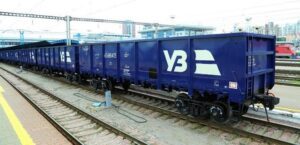
The number of refugees from Ukraine registered for temporary protection or similar national protection schemes in Europe reached 5 million 8.28 thousand as of March 28, 2023, the UN High Commissioner for Refugees (UNHCR) said on its website.
In the nearly two months since Jan. 31, the increase was 185,15,000, up from 72,300 in the previous slightly longer period, and a total of about 2 million since the end of May 2022.
The number of refugees with Temporary Protection status in Europe, towards the end of January, was very close to the mark of 5 million, reaching 4.95 million. But then the data of Germany was updated for two months, which recorded a decrease of Ukrainians in the country with such status immediately by more than 140 thousand – down to 881,4 thousand.
The next update of this data for Germany at the end of March showed growth again – up to 922.66 thousand.
According to UNHCR data, collected from the national governments, most refugees with temporary protection statuses are still in Poland – 1 million 577,29 thousand for almost two months their number increased by 14 thousand. Total number of refugees from Ukraine, according to the Polish border service since the war began, was 10.819 million people, and in the opposite direction to Ukraine 8.966 million left.
The third place in the receipt of Ukrainians is occupied by the Czech Republic, where the number of people registered for temporary protection increased from the end of January by 16.9 thousand – to 502.0 thousand.
The fourth place is occupied by the United Kingdom – 191,9 thousand (with increase of 33,1 thousand).
Italy now occupies the fifth place – 173.21 thousand (an increase of 2.9 thousand), and Spain is on the third place with a small gap – 171.87 thousand (an increase of 10.9 thousand).
Bulgaria goes next with an indicator of 155.46 thousand (3.8 thousand increase), and Romania – 123.76 thousand (an increase of 12.9 thousand).
There are more than 100 thousand Ukrainians registered for temporary protection in two countries – France and Slovakia: 118.99 thousand (data as of October 21) and 112.72 thousand (increase by 5.7 thousand).
Austria also has from 50 thousand to 100 thousand refugees from Ukraine with temporary protection status – 94.98 thousand (2.5 thousand more), the Netherlands – 89.73 thousand (4.5 thousand more), Switzerland – 83.43 thousand (4.5 thousand more), Lithuania – 76.16 thousand (2.6 thousand more).
These figures also include Ireland – 78.03 thousand (growth by 5.4 thousand), Belgium – 69.25 thousand (growth by 4.9 thousand), Portugal – 58.24 thousand (growth by 1.1 thousand), Sweden – 53.51 thousand (growth by 2.3 thousand) and Finland – 52.47 thousand (growth by 3.2 thousand).
Latvia goes next with indicators from 25 thousand to 50 thousand – 46.86 thousand (an increase of 1.6 thousand), Estonia – 44.40 thousand (an increase of 1.6 thousand), Norway – 44.01 thousand (an increase of 5.4 thousand), Denmark – 39.22 thousand (an increase of 1.5 thousand) and Hungary – 34.25 thousand (an increase of 0.7 thousand).
From 10 to 25 thousand refugees from Ukraine with temporary protection status in Cyprus – 21.84 thousand (an increase of 1.2 thousand), in Croatia – 21.35 thousand (an increase of 0.9 thousand), and in Greece – 20.96 thousand (data of December 6).
In addition, the UN statistics on refugees of Ukraine received temporary protection status in Slovenia – 8.92 thousand, Montenegro – 8.30 thousand, Luxemburg – 6.76 thousand (data of October 25), Iceland – 2.35 thousand (data of December 31), Malta – 1.74 thousand, Serbia and Kosovo – 1.28 thousand, Liechtenstein – 0.54 thousand and Albania – 0.03 thousand.
The UN also indicates countries with registered refugees from Ukraine, but no data on their status: Moldova – 107.01 thousand, Turkey – 95.87 thousand, Georgia – 25.70 thousand, North Macedonia – 6.57 thousand, Azerbaijan – 5.03 thousand, Armenia – 0.55 thousand and Bosnia and Herzegovina – 0.17 thousand.
The UN separately indicates Russia and Belarus, where the Ukrainian border was crossed by 2 million 852.4 thousand and 16.71 thousand people, respectively, but since October 3, the data for Russia are no longer updated, while that for Belarus is even older. According to the UN, the Russian Federation recorded all who crossed the border, while in Belarus – 21.83 thousand. There are no data on their status, as well as data on crossing the border of Ukraine in the opposite direction.
According to the UNHCR data as of March 28, a total of 19.741 million people left Ukraine since the beginning of the war (not counting the flow of people into the country), including 10.452 million people to Poland, 2.852 million people to Russia (data of October 3), 2.415 million people to Hungary, 2.154 million people to Romania, 1.267 million people to Slovakia, 795.6 million people to Moldova and 16.7 thousand people to Belarus.
At the same time, according to the UN, 11.200 million people arrived in Ukraine from February 28, 2022 to March 28, 2023 (excluding the data of Hungary, Russia and Belarus).
The organization recalls that in mid-2021, there were only 53.47 thousand Ukrainian refugees in the world, who sought the appropriate status, including 36.49 thousand in Europe.
The Ukrainian diaspora in the world by mid-2020, UNHCR estimated at 6.1 million, including in Europe – 5 million.

Stabilization of the Ukrainian energy system and a certain reserve of capacity allow discussing the opening of electricity exports to Europe, Energy Minister Herman Galushchenko said.
“The issue of opening exports is already on the table today. It is being considered,” the minister said on the air of the national telethon “Unified News” on Friday.
Depending on the volume of imports, he said, it could bring Ukraine up to $70 million a month and help restore energy facilities after Russian attacks.
At the same time, the head of the Energy Ministry stressed that Ukraine would refuse to export electricity in case of shortages.
As earlier reported, export of electric power was stopped by order of the Minister of Energy since October 11, 2022, after the beginning of massive Russian attacks on Ukraine’s energy system. The capacity allowed by European network of transmission system operators ENTSO-E for export is 400 MW, for import – 850 MW.
The head of Ukrhydroenergo, Igor Sirota, in an interview with Interfax-Ukraine noted that Ukraine has been experiencing a 24-hour power surplus for several weeks in a row, which would be advisable to sell. Nevertheless, he stressed that “there is a lot of politics in this issue,” as there are a number of consumers who do not receive electricity. At the same time, the head of the general company explained that such consumers are deprived of power supply not because of the resource shortage, but precisely because of low network capacity.

Eurogroup finance ministers believe the collapse of U.S.-based Silicon Valley Bank (SVB) will not have a direct impact on Europe’s financial system, but is a signal of the importance of ensuring the stability of the EU banking system amid ongoing uncertainty.
“Since this bank’s presence in the EU is very, very limited, we do not see direct consequences, but we are closely monitoring developments and we take note of the strong reaction of the U.S. authorities,” EU Economy Commissioner Paolo Gentiloni said after the Eurogroup meeting in Brussels.
He noted that the eurozone economy has entered this year in slightly better shape than expected a few months ago, but turmoil in the banking system amid general volatility could arise at any time.
“Uncertainty remains very high,” the European commissioner stressed.
Eurogroup Chairman Pascal Donohue said the SVB collapse, which shook up the U.S. financial system, was one of the topics of discussion among European ministers.
“The problems (in America) arose because of the specific business model of the bank (…) and the picture here in Europe is very different. Our banks are generally in good shape,” Donohue assured.
The Eurogroup’s statement from the meeting notes that the eurozone economy has recovered significantly from the pandemic and has weathered the effects of rising energy prices. Nevertheless, economic growth is expected to “remain modest in 2023 and gradually accelerate in 2024.”
“While uncertainty about the outlook, especially geopolitical and energy factors, remains elevated, the risks to growth appear more balanced than before. This reinforces the need for fiscal policy to remain flexible,” the statement said.
The Eurogroup gave forward-looking guidelines for fiscal policy in the euro zone. Between 2023 and 2024, it should focus on debt sustainability over the medium term as well as sustained improvements in economic growth and addressing the transition to green and digital technologies through investment and reforms.

Ukrzaliznytsia JSC (UZ) may create a freight carrier company by the end of 2023 to operate in Europe, UZ board chairman Alexander Kamyshyn confirmed to Interfax-Ukraine news agency.
“It is true, we have to develop a European carrier both in passenger transportation and in cargo transportation. We have shown that we can be efficient, and those of our citizens who have used the services of European railroads have appreciated the difference in schedule, service, and many other things,” Kamyshyn said.
The necessity of creating one’s own company for cargo transportation outside of Ukraine is dictated by the fact that Ukrainian cargo carriers have difficulties working with European carriers. “Unfortunately, it is difficult for our cargo carriers to use European freight,” said Kamyshyn.
According to the head of UZ, such a company can be created by the end of the year. “There is hope, and we are doing everything to make it come true, but the speed of approvals in Europe, unfortunately, we would like it to be faster,” said Kamyshyn.
He also noticed that in order to establish a cargo carrier company one should not only buy the rolling stock, but also to get a license, to register and to hire a team.
Earlier it was reported that in the framework of the project UZ bought 40 tank cars European way, which will be supplied to the chain of diesel fuel in Ukraine, and plans to buy 100 fitting platforms.

Demand for office space in Europe recovered sharply last year, recovering from the effects of the coronavirus pandemic, which contributed to rental growth and partially compensated for the price correction associated with rising interest rates, according to a Cushman & Wakefield review.
According to the experts, in total 12.6 million square meters of office space was leased in Europe in 2022. The figure rose by 15% compared to the previous year, when many employees of companies worked remotely because of the pandemic.
Rents were up 6.2% in the fourth quarter of 2022 from a year earlier. This is the fastest year-over-year increase since mid-2008.
The strong demand for office space is due in part to companies looking to bring employees back to their offices after the removal of anti-covid restrictions.
“Tenants are focused on taking the best offices in their segment in the most attractive locations to attract and retain employees,” said Nigel Almond, director of data analytics at Cushman & Wakefield.
Companies also want to occupy offices in buildings that meet environmental standards, which have become more stringent, the expert said.
Analysts recorded an increase in activity in 23 out of 30 European markets of office buildings, which it monitors. Meanwhile, it was not active enough to compensate for the increase in the amount of available office space.
According to the company, the total available office space in Europe increased by 0.7% to 22.6 million square meters. The lowest level of availability was recorded in Luxembourg – 4,2%.

President of the European Parliament Roberta Metsola believes Ukraine will become a member of the European Union.
On Thursday in Brussels at the European Parliament, welcoming Ukrainian President Volodymyr Zelensky, she said: “I am proud to say that this House of European Democracy, its members, our European Union – have always stood with you. We understand that you are fighting not only for your values, but for ours. For those ideals that bind us as sisters and brothers. That make us, all, European. Because Ukraine is Europe and your nation’s future is in the European Union.”
The President of the European Parliament called for the EU to show support for Ukraine “not only with words but with action: with the political will to ensure easier trade with the fastest possible accession process. With funds for your people, with help in reconstruction, with training for your troops. With military equipment and defense systems you need to win.”
Metsola also said the world is going through “extraordinary times” right now. “It has been almost one year since the brutal, illegal invasion of sovereign Ukraine by Russia. In all that time, Mr President, your leadership has inspired your people and inspired every corner of the globe. When the world thinks of Ukraine they think of heroes fighting the odds, of David beating Goliath,” she said.
The President of the European Parliament also called the decision of the Ukrainian leadership to send aid to the victims of the earthquake in Turkey and Syria “real solidarity.”